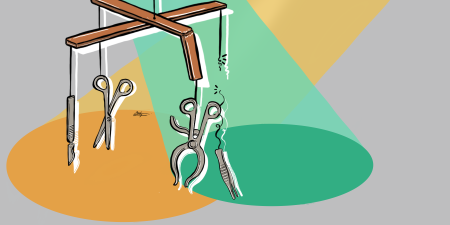Abstract
Since their adoption during the 1990s, minimally invasive surgical techniques have demonstrated postoperative surgical recovery benefits for patients. As robotic surgery platforms continue to be developed and utilized in surgical specialty areas, dexterity and visual field limitations of laparoscopy are coming under close clinical and ethical scrutiny. This article compares robotic and laparoscopic modalities, with special attention to dexterity, surgeon performance, ergonomics, and patient outcomes. This article also examines robotic platforms’ advantages for surgeons’ technical capacity and career longevity.
Introduction
Minimally invasive surgical (MIS) techniques have been a major factor in improving how surgeons provide care to patients. In the 1990s, the rise in popularity of laparoscopic cholecystectomy focused attention on how best to minimize patient morbidity across a multitude of surgical specialties.1 The increased utilization of an MIS approach has translated into improved patient outcomes in terms of lower rates of complications, decreased postoperative pain, and shorter hospital length of stay.2 For example, the transition from an open to a laparoscopic approach for adrenalectomies reduced average inpatient hospital length of stay from 9.8 days to 5.1 days in one study published in 1996 and subsequently down to 2.4 days the following year when the study was repeated.3,4
The benefits of an MIS approach have been particularly profound in the obese patient population. As obesity becomes more prevalent in the United States, a push toward smaller surgical incisions will accrue a variety of benefits to these patients, including improvement in postoperative outcomes. Shortly after the introduction of laparoscopic techniques for weight loss facilitation, one study demonstrated that, compared to patients who underwent open surgery, patients who underwent laparoscopic Roux-en-Y gastric bypasses had significantly decreased mean operative times (246 vs 294 minutes, respectively) and shorter mean length of hospital stay (4.0 vs 8.4 days, respectively), as well as less frequent superficial and severe wound infections (2.9% vs 8.6%, respectively).5
Robotic Surgery Platforms Improve Surgeon Performance
As more specialties utilize laparoscopy as a surgical modality, it has become increasingly evident that, despite its benefits for patient care, the technique has certain operative and physical limitations. Laparoscopy is dependent on 2-dimensional (2D) vision and has decreased range of movement relative to open surgery on account of the rigidity of the instruments, resulting in overall reduced surgical dexterity.5 Flexible laparoscopic instruments exist but do not correct for major deficiencies. The introduction of the robotic surgery platform has vastly improved the deficiencies of traditional laparoscopy by introducing 3-dimensional (3D) vision, further degrees of instrument articulation, and the ability to abolish some tremor through robotic stabilization. These advantages allow for improved hand-eye coordination and overall surgical precision.6 In a study of 10 surgeons with varying experience with an MIS suturing task, Moorthy et al showed that, compared to laparoscopy, the robotic platform enhanced by nearly 50% surgical dexterity, defined by the total number of errors observed during task completion (such as fumbling the needle, multiple attempts made with needle handling, and loose sutures).7 Moreover, the authors found that robotic 3D vision improved dexterity by 10% to 15% over robotic 2D vision, with a concomitant 93% reduction in operative errors.7 Similarly, in a study of 5 surgeons performing a robotic suturing task in 3 different scenarios—use of dominant hand with 3D vision, use of dominant hand with 2D vision, and use of nondominant hand with 3D vision—Ishikawa et al found that average robotic suturing time was significantly faster with the utilization of 3D than 2D vision (211.7 vs 331.1 seconds, respectively), even when the surgeon’s nondominant rather than dominant hand was used to perform the task (237.1 vs 331.1 seconds, respectively).8 The benefits of robotic surgery are preserved even among novice surgeons. Park et al found that surgeons classified as having intermediate experience (completion of 20-99 cases) and novices (completion of fewer than 20 cases) with MIS laparoscopic (using both 2D and 3D vision) and robotic (3D) platforms struggled more with task completion using laparoscopy, particularly 2D, but were proficient when using the robotic assisted system.9 The expert group (completion of at least 100 laparoscopic procedures) completed each task with similar efficiency regardless of platform used.9 These findings demonstrate that surgeons with limited MIS experience may benefit more from the compensatory features of a robotic-assisted platform than from traditional laparoscopy. Moreover, this technology may aid surgeons later in their careers, especially as their performance may start to deteriorate due to tremor or other musculoskeletal hindrances, such as overuse injuries. Several studies have shown that computer-aided devices or microsurgery help compensate for physical attributes like slight tremors,10,11 but none have evaluated or followed surgeons over time to determine whether their careers were prolonged by use of microsurgery or whether they were still able to offer at least MIS techniques as they aged.
Improved Ergonomics
Utilization of robotic surgery techniques has also been shown to provide improved operative ergonomics in several surgical specialties. A recent meta-analysis that included 29 articles comprising 3074 participants evaluated surgical ergonomics across laparoscopic, open, and robotic platforms in a multitude of specialties, including general surgery, gynecologic surgery, and endocrine surgery.11 Roughly half the studies used electromyography (EMG) data regarding muscle activation to measure overuse and fatigue; the other half utilized the National Aeronautics and Space Administration Task Load Index (NASA-TLX), an assessment tool that captures both mental and physical demands as well as total effort and participant frustration with tasks. One survey included in the analysis found that significantly fewer surgeons reported physical discomfort with the robotic surgery platform than with laparoscopy and open surgery (8.3% vs 55.4% vs 36.3%, respectively).12 In another included study of 13 MIS-trained surgeons whose performance on 6 surgical training tasks was evaluated using EMG monitoring and post-task NASA-TLX surveys, it was found that performance of the tasks using the robotic platform significantly decreased strain from the biceps and flexor carpi ulnaris muscles relative to laparoscopy.13 Additionally, evaluation of the NASA-TLX survey data indicated that, regardless of surgeons’ experience with MIS surgery, tasks completed on the robotic platform involved less cognitive workload than the same tasks completed with laparoscopy.13
Utilization of robotic surgery techniques has also been shown to provide improved operative ergonomics in several surgical specialties.
Similar results were found in studies that focused on suturing. In an evaluation of MIS surgeons who performed both a pin movement and a suturing task, Berguer and Smith found that there was significantly less muscle engagement in the thumb, as measured by EMG, with the robotic system than with laparoscopy.14 The study also evaluated skin conductance values, which were lower during the robotic tasks, suggesting a decrease in overall mental stress during task completion.14 Similarly, Stefanidis et al showed that robotic surgery was significantly less physically demanding than laparoscopy, as measured by NASA-TLX score (13 vs 5, respectively).15 Interestingly, contra earlier studies, newer research shows that these benefits are more pronounced in more experienced surgeons. One study found that surgeons who performed more than 20 MIS cases per month were not more likely to experience physical symptoms related to operating than those who performed fewer than 6 cases per month; however, those who performed 6 to 10 or 11 to 20 cases per month had significantly higher odds of experiencing any symptom than those who performed fewer than 6 cases per month.16 Given that discomfort tends to increase with case load, some institutions have instituted ergonomic programs to reduce physician fatigue.17,18 Clearly, less physical and mental fatigue would allow surgeons to perform at a higher level for longer durations of time. In theory, reduced fatigue should extend surgeons’ careers, as they would experience less physical strain. It will be important to track the longevity of surgeons’ careers as more of the current generation of surgeons adopt the robotic surgical platform for minimally invasive-amenable operations.
Comparison of Patient Outcomes
Given robotic surgery’s benefits of reduced physical and mental fatigue and reduced physical strain relative to laparoscopy—especially for frequent users of the approach—several studies have sought to evaluate whether a robotic approach improves patient outcomes compared to a laparoscopic approach. Studies have shown that, across multiple specialties—including general surgery and surgical oncology—patients who undergo robotic-assisted surgery have significantly less postoperative pain, reduced open conversion rate, and shorter postoperative length of stay than patients who undergo laparoscopic surgery.19,20 In comparisons of patients who underwent robotic, laparoscopic, and open inguinal hernia repairs for recurrent inguinal hernias, significantly fewer patients who underwent a robotic repair needed prescription pain medication than patients who underwent laparoscopic surgery (45.3% v 65.4%) or open surgery (49.5% vs 80%).21 It should be noted, however, that patients who underwent robotic surgery had a significantly longer average operative time than patients who underwent laparoscopic surgery (83 minutes vs 65 minutes, respectively).21 Another study of perioperative outcomes for abdominoperineal resections for colorectal cancer at one institution found that, compared to patients who underwent laparoscopic surgery, patients who underwent robotic surgery had a significantly reduced complication rate (13.2% vs 23.7%, respectively), a significantly reduced open conversion rate (0% vs 2.9%, respectively), and a significantly shorter median hospital length of stay (5.0 vs 7.0 days, respectively), with no effect on long-term oncological outcomes.22
Pitfalls
Despite its significant benefits in added wrist articulation and visualization, as previously mentioned, one major shortcoming of the robotic platform compared to laparoscopy is the lack of tactile feedback. When evaluating the learning curve for robotic assisted-surgery in colorectal surgery, one study found that one of the main barriers to mastery was the surgeon’s inability to substitute visual cues for tactile feedback.23 While no products are currently available, several enhancements have been proposed to the robotic platform, mostly for neurological or orthopedic procedures, to allow for haptic feedback.24 Finally, implementation of a robotic program has significant upfront costs, including purchase of the system and hiring and training of staff, as well as long-term maintenance and platform upgrade costs. A 2010 study found that, on average across a variety of surgical procedures, utilization of the robotic platform added roughly $1600 to the costs of laparoscopy. When the overall cost of the robot itself was included, the added costs climbed to $3200.25
Conclusion
MIS techniques clearly provide advantages from both a patient and hospital systems standpoint. However, the robotic platform allows for better compensation of human factors that surgeons face than laparoscopy, and those benefits should not be brushed away. The benefits of robotic surgery in terms of improved proficiency, dexterity, and reduction in mental and physical fatigue have been shown to translate into improved patient outcomes. Resultant reductions in pain, complications, and length of hospital stay provide benefits for patient well-being during surgical recovery as well as reduced hospital costs that benefit the entire health care system. While novices certainly can benefit from this technique, it is important to acknowledge that the current literature supports that surgeons specifically trained in this modality show the greatest benefit.
Studies and resources focusing on surgical training and ergonomic programs in residencies and even in medical school education are underway to start this learning process earlier. It is clear that, as technology continues to evolve and is more widely adopted in training programs, we will be training better, more proficient, and more ergonomically minded surgeons, which ultimately will facilitate delivery of the best care to patients while also preserving the longevity of surgeons’ careers.
References
- Grace P, Quereshi A, Darzi A, et al. Laparoscopic cholecystectomy: a hundred consecutive cases. Ir Med J. 1991;84(1):12-14.
-
Darzi A, Munz Y. The impact of minimally invasive surgical techniques. Annu Rev Med. 2004;55:223-237.
- Rutherford JC, Stowasser M, Tunny TJ, Klemm SA, Gordon RD. Laparoscopic adrenalectomy. World J Surg. 1996;20(7):758-760.
- Gagner M, Pomp A, Heniford BT, Pharand D, Lacroix A. Laparoscopic adrenalectomy: lessons learned from 100 consecutive procedures. Ann Surg. 1997;226(3):238-246.
- Nguyen NT, Ho HS, Palmer LS, Wolfe BM. A comparison study of laparoscopic versus open gastric bypass for morbid obesity. J Am Coll Surg. 2000;191(2):149-155.
-
Pandey SK, Sharma V. Robotics and ophthalmology: are we there yet? Indian J Ophthalmol. 2019;67(7):988-994.
- Moorthy K, Munz Y, Dosis A, et al. Dexterity enhancement with robotic surgery. Surg Endosc. 2004;18(5):790-795.
- Ishikawa N, Watanabe G, Hirano Y, Inaki N, Kawachi K, Oda M. Robotic dexterity: evaluation of three-dimensional monitoring system and non-dominant hand maneuverability in robotic surgery. J Robot Surg. 2007;1(3):231-233.
- Park YS, Oo AM, Son SY, et al. Is a robotic system really better than the three-dimensional laparoscopic system in terms of suturing performance?: comparison among operators with different levels of experience. Surg Endosc. 2016;30(4):1485-1490.
- Ramdhian RM, Bednar M, Mantovani GR, Facca SA, Liverneaux PA. Microsurgery and telemicrosurgery training: a comparative study. J Reconstr Microsurg. 2011;27(9):537-542.
-
Wee IJY, Kuo LJ, Ngu JC. A systematic review of the true benefit of robotic surgery: ergonomics. Int J Med Robot. 2020;16(4):e2113.
- Plerhoples TA, Hernandez-Boussard T, Wren SM. The aching surgeon: a survey of physical discomfort and symptoms following open, laparoscopic, and robotic surgery. J Robot Surg. 2012;6(1):65-72.
-
Lee G, Lee M, Clanton T, Marohn M. Comprehensive assessment of skill-related physical and cognitive ergonomics associated with robotic and traditional laparoscopic surgeries. Sages. Accessed April 28, 2023. https://www.sages.org/meetings/annual-meeting/abstracts-archive/comprehensive-assessment-of-skill-related-physical-and-cognitive-ergonomics-associated-with-robotic-and-traditional-laparoscopic-surgeries/
- Berguer R, Smith W. An ergonomic comparison of robotic and laparoscopic technique: the influence of surgeon experience and task complexity. J Surg Res. 2006;134(1):87-92.
- Stefanidis D, Hope WW, Scott DJ. Robotic suturing on the FLS model possesses construct validity, is less physically demanding, and is favored by more surgeons compared with laparoscopy. Surg Endosc. 2011;25(7):2141-2146.
- McDonald ME, Ramirez PT, Munsell MF, et al. Physician pain and discomfort during minimally invasive gynecologic cancer surgery. Gynecol Oncol. 2014;134(2):243-247.
- Franasiak J, Ko EM, Kidd J, et al. Physical strain and urgent need for ergonomic training among gynecologic oncologists who perform minimally invasive surgery. Gynecol Oncol. 2012;126(3):437-442.
-
Franasiak J, Craven R, Mosaly P, Gehrig PA. Feasibility and acceptance of a robotic surgery ergonomic training program. JSLS. 2014;18(4):e2014.00166.
-
Sucandy I, Rayman S, Lai EC, et al; International Robotic, Laparoscopic Liver Resection Study Group Investigators. Robotic versus laparoscopic left and extended left hepatectomy: an international multicenter study propensity score-matched analysis. Ann Surg Oncol. 2022;29(13):8398-8406.
-
Sun Y, Xu H, Li Z, et al. Robotic versus laparoscopic low anterior resection for rectal cancer: a meta-analysis. World J Surg Oncol. 2016;14:61.
-
LeBlanc K, Dickens E, Gonzalez A, et al; Prospective Hernia Study Group. Prospective, multicenter, pairwise analysis of robotic-assisted inguinal hernia repair with open and laparoscopic inguinal hernia repair: early results from the Prospective Hernia Study. Hernia. 2020;24(5):1069-1081.
- Feng Q, Tang W, Zhang Z, et al. Robotic versus laparoscopic abdominoperineal resections for low rectal cancer: a single-center randomized controlled trial. J Surg Oncol. 2022;126(8):1481-1493.
- Bokhari MB, Patel CB, Ramos-Valadez DI, Ragupathi M, Haas EM. Learning curve for robotic-assisted laparoscopic colorectal surgery. Surg Endosc. 2011;25(3):855-860.
- Amirabdollahian F, Livatino S, Vahedi B, et al. Prevalence of haptic feedback in robot-mediated surgery: a systematic review of literature. J Robot Surg. 2018;12(1):11-25.
- Barbash GI, Glied SA. New technology and health care costs—the case of robot-assisted surgery. N Engl J Med. 2010;363(8):701-704.



